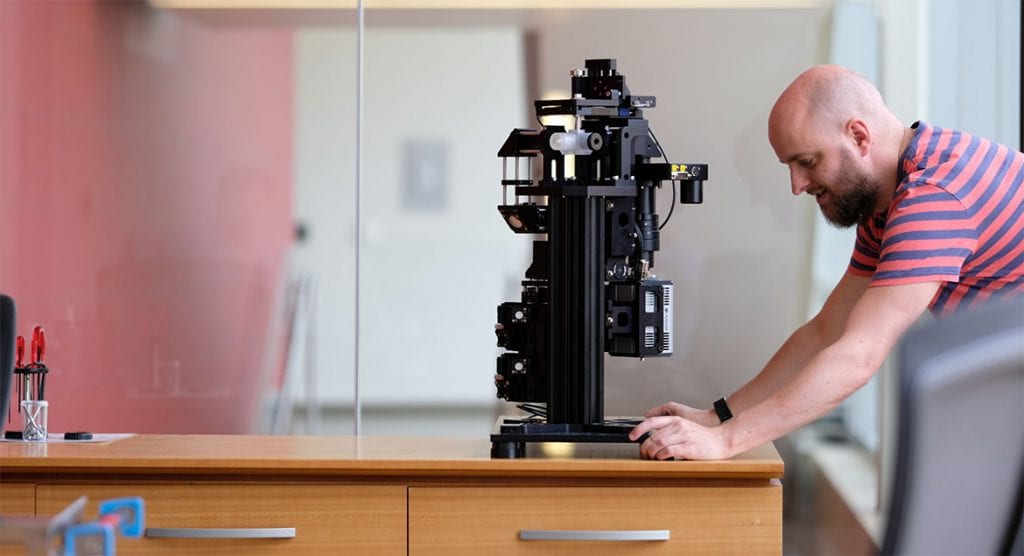It’s time to rethink how we use microscopes.
Over the centuries, these amazing instruments have become highly complex and delicate. Many have to sit on special tables that limit vibrations. Even more troublesome is how difficult they are to transport. This presents challenges for biologists who find it almost impossible to bring fragile specimens from locations such as rivers, volcanos, or deep forests back to the lab.
The images they can capture are astounding, but the best microscopes have become highly expensive and are found only at top research labs and universities. Topping a million dollars each, they are out of reach of many promising scientists unable to afford the chance to dream up an experiment and secure exactly the technology they need to conduct that research.
This restricted access to crucial technology is a cause for concern for people who care about science. At the Morgridge Institute for Research at UW–Madison, we are working to bridge the gap in access to high-level imaging by developing a small, modular microscope that can be shared among multiple researchers and operated in even the most remote locations.
Called the Flamingo – a playful nod to the fact they can be used on the go – our microscope is no larger or heavier than a small suitcase and will cost about $50,000. We have already developed a prototype and hope to build several more instruments this year.
We aim to ultimately make Flamingos available to scientists around the world who could not otherwise have access to commercial instruments. But the impact on science will be far greater than affordable equipment. This approach to technology will help democratize science by addressing a number of important elements we grapple with in scientific research today.

Creativity and speed
The traditional concept of a biological imaging experiment is a long process of a researcher building up a reputation, writing a grant, and getting funding from NIH that includes money to buy a commercial instrument that is very expensive. Years can pass since the idea first occurred to do the experiment. Flamingo will allow any researcher with a great idea at any career level — a grad student as well as a professor — launch innovative experiments quickly, based on the project, not the reputation of a lab or institute.
Flamingos will be made of modular parts that can be speedily interchanged depending on the particular needs of the biologist. That’s especially important for cutting-edge research, as it can take several years for manufacturers to bring advanced new microscopes to market.
Technology
Conventional, commercially available techniques are geared towards imaging something small like cells or tissue sections that are fixed, and stained, and dead on a slide. Our microscopes let you look at an entire embryo, alive and developing in a movie. Called light sheet microscopes, they illuminate subjects with “sheets” of light that give scientists the ability to image samples over days from any angle — and capture the specimen in a natural, undisturbed state. This gives researchers a 3D view of tissue from a biopsy, for example, or from the developing embryo of a transparent zebrafish, and a great deal of data quickly.
Collaboration
If a biologist wants to talk to the engineer who designed her telescope, they might jump on a Skype call now. We are designing remote access so we can calibrate the device from anywhere. We will share these microscopes for free, in the spirit of scientific collaboration, and work closely with scientists to make sure the design meets their needs. From our perspective, we learn from these scientists how to build even better microscopes. We want to develop a scientist-to-scientist, not a company-to-customer, sort of relationship. We are also developing software that will give scientists real-time desktop and mobile access to instruments and data. Biologists, engineers, and computer scientists can basically remotely login to the instrument and run an experiment together.
Transparency
A key element of science is for a researcher to reproduce the results published by another scientist and then build on it. The images and data produced by Flamingo users will be posted and shared, offering unprecedented access. Moreover, instruments are shipped from one lab to another as one project ends and another begins, researchers will be able to easily reproduce the experiments by former Flamingo users, helping to speed up and confirm scientific discoveries. We expect one instrument to remain at a lab for two months, serving six labs a year.
So far, we have had about 180 scientists, from neuroscientists to astrobotanists, express an interest in Flamingo, including Mary Halloran, an integrated biology professor here in Madison who has been researching fish embryos. A grant from the Chan Zuckerberg Initiative will fund an imaging scientist to travel from lab to lab with the Flamingo, helping our collaborators set it up and creating training materials.
This is changing how we do research, offering a chance for biologists who have a crazy idea to reach out to us do some great research. Together we hope to answer some of biology’s intractable mysteries, one microscope at a time.
Jan Huisken is an investigator at the Morgridge Institute for Research and visiting professor of integrative biology at the University of Wisconsin–Madison. He is co-inventor of light sheet microscopy.
